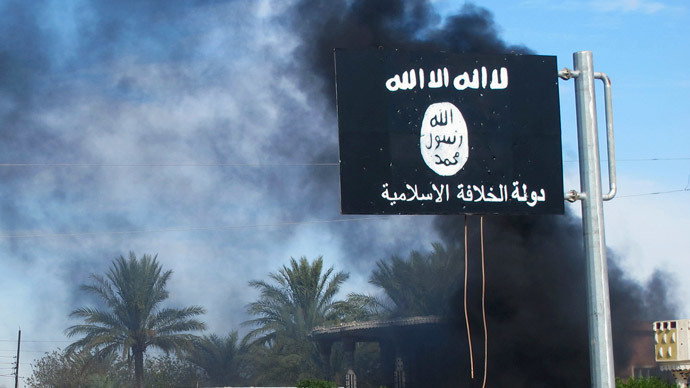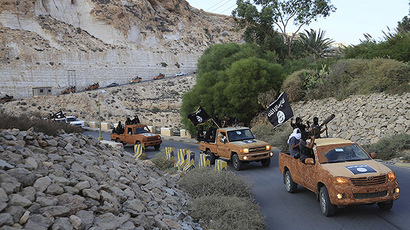UN Security Council: ISIS replacing Taliban in Afghanistan

The Islamic State has infiltrated into Afghanistan and is attempting to step into the Taliban's boots, acknowledged the UN Security Council. Russia’s representative to the UN warns Central Asian states could be the next stop for the Islamic extremists.
The presence of the Islamic State (IS, formerly ISIS/ISIL) fighters in the country has been confirmed by the United Nations Assistance Mission in Afghanistan (UNAMA).
The UN envoy to Afghanistan acknowledged that the IS could potentially unite minor Islamist groups in the country under a new command.
“It is UNAMA’s assessment that the group's presence is of concern, but that ISIL's significance is not so much a function of its intrinsic capacities in the area but of its potential to offer an alternative flagpole to which otherwise isolated insurgent splinter groups can rally,” Nicholas Haysom announced at the UN Security Council, as cited by the Associated Press. Still, the IS has not established “firm roots” in the Afghanistan, he noted.
RT @khaama: UN concerned over #ISIS presence in #Afghanistanhttp://t.co/EFiUHTRaa2pic.twitter.com/sl212KZXeZ
— thomas_wiegold (@thomas_wiegold) March 17, 2015
Moscow has rushed to voice concern with the IS broadening its geographical activities into Afghanistan and spreading radical Islam further to the north into other Central Asian states.
Russia’s representative in the UN expressed deep concern with “increasingly frequent reports of the worsening situation in the north of Afghanistan, in areas bordering countries which were once Soviet republics and remain ‘our friends and allies.’”
READ MORE: 20,000 foreigners have joined ISIS in Iraq, Syria – reports
Vladimir Safronkov, Russia's deputy UN ambassador, called on to the UN Security Council to react immediately to prevent the IS’s further expansion that could “rock the boat” and destabilize the situation in Afghanistan with its newly-elected administration.
“The states of the region have legitimate concerns about this turn of events,” he said, according to the AP. “Turning it into yet another safe haven for fighters and extremists is categorically unacceptable.”
Afghanistan's UN Ambassador Zahir Tanin confirmed information about the IS infiltrating Afghanistan, but stressed that “the main enemy we face is the Taliban that continue to fight against us,” marking out the presence of “some splinter groups with more extreme orientations.”
In early 2015, suspicion emerged that the IS is trying to replace white flags of the Taliban with their own black ones in war-torn Afghanistan.
READ MORE: High finance: ISIS generates up to $1bn annually from trafficking Afghan heroin
ISIS Earns $1 Billion Dollars Annually For Delivering Afghanistan Heroin http://t.co/uegsU8Ie7Ppic.twitter.com/kZOkH8MXt4
— The Future 未来 (@9ja_Ninja) March 8, 2015
In January, Taliban-associated militants claimed that several minor groups in Pakistan and Afghanistan established close contacts with the self-proclaimed caliph of ISIS, Abu Bakr al-Baghdadi. Later on senior Afghan and US army officials acknowledged that ISIS is doing “some recruiting” in the country.
Kabul is already battling the IS on its own soil. On Monday the news came that an airstrike by Afghan forces on Sunday eliminated militant commander Hafiz Waheed, who allegedly had ties to the IS.
The warlord was a successor to Abdul Rauf Khadim, killed in a US drone strike last month. Khadim, Waheed’s uncle, once a Taliban commander and Guantanamo detainee, allegedly used to have allegiance to the IS.
READ MORE: ISIS too reliant on oil, can’t survive without new territories – report
Former Afghani Mujahideens are now forming their own militias to prevent the possible spread of ISIS into Afghanistan pic.twitter.com/YG9Ydw0uw0
— Nael Sanaullah (@NaelSanaullah) February 25, 2015
The US administration does realize the dangers of leaving Afghanistan all alone against the growing terror threat and might slow the process of withdrawing the remaining troops, the Associated Press reported on Saturday. With 10,000 American troops currently deployed to Afghanistan, Washington intended to decrease this number to 5,500 by the end of 2015 and withdraw all the troops completely by the end of Barack Obama’s second presidential term in 2016.
READ MORE: Obama to blame for ISIS rise, kill them like Nazis - Palin
Now the US and Afghanistan are likely to reassess this schedule in special consultations due to take place shortly to make the withdrawal smoother and over a longer period.
2014 was marked with Afghanistan entering a new cycle of violence, becoming the bloodiest year since 2009. Nearly 3,700 civilians were killed in Afghanistan last year, according to the UN report released in February.














